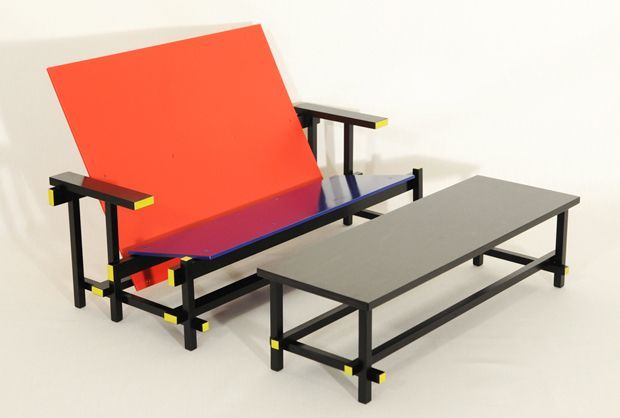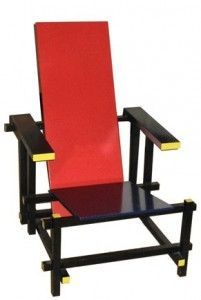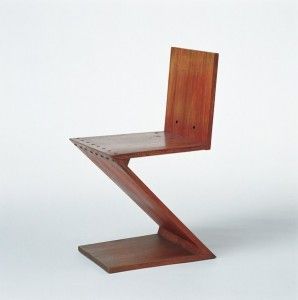
Rietveld, a Dutch carpenter and architect that belonged to the De Stijil movement, was among the first designers of furniture and toys for children
The design of familiar furniture or toys, is often closely linked to the architectural career of its author. This is the case of Gerrit Thomas Rietveld.
Rietveld’s passion for furniture began in his childhood at his father’s workshop from whom he learned carpentry. He was still studying architecture when he started his own factory where innovative ideas for his time would take shape, such as the children furniture chair made in 1915, his most emblematic icon, the Red and Blue Chair, – then just finished in wood – in 1918; it represented the construction essence based on geometric concepts that lead to reduced to a limited number of planes the most complex shapes from a modern thinking and to focus on innovative materials like plywood.
 A year later he would be part of the De Stijl movement which had a great influence on him, and with their characteristic colors the Red and Blue Chair was made an icon of modernity.At the same time, he would meet an interior designer named Truus Schröder-Schräder with whom he would create his most emblematic architectural work: the Rietveld Schröder House in Utrecht. He used the same sense of functionality that he already employed in his furniture was used by him to create a family home, which had the ability to modify the staying area of the house through the interplay of primary layouts with different colors peculiar of the De Stijl movement.
A year later he would be part of the De Stijl movement which had a great influence on him, and with their characteristic colors the Red and Blue Chair was made an icon of modernity.At the same time, he would meet an interior designer named Truus Schröder-Schräder with whom he would create his most emblematic architectural work: the Rietveld Schröder House in Utrecht. He used the same sense of functionality that he already employed in his furniture was used by him to create a family home, which had the ability to modify the staying area of the house through the interplay of primary layouts with different colors peculiar of the De Stijl movement.
However, in 1934, Rietveld was influenced by the most rationalist tendencies, which were predominating after the period of economic recession. This led him to project simpler and cheaper furniture, as e.g. the Zig-zag chair or the Crate chair as well as the Krat set, which are examples of reusing materials at a low cost. So simplification and optimization emerged again as imperative elements in his work, but without neglecting an innovative design. With these new concepts, Rietveld anticipated the current trends of “DIY” by publishing his designs in brochures and which allowed people to assemble their own furniture.

MRI 1002
But Rietveld would not only design furniture for adults; many of his works were adapted for children, such is the case of his famous Zig-zag chair. Moreover, his creativity led him create toys for children as his wheelbarrow or the Buggy, both designed in 1923. These examples represent the formal essence of his most important deeds, but adapted for children. Rietveld even made a garden playhouse, based on one of his architectural works and filled it with the same furniture.
After 1945, Rietveld focused more on his architectural work by creating prestigious buildings like the Dutch pavilion for the Biennale of Venice or the Sonsbeek Pavilion, but without abandoning the design of furniture, in which he even designed an upholstered armchair for the UNESCO headquarters in Paris in 1958, his last great furniture design. Currently, the official allocation of his designs belongs to the furnishing company Cassina Cassina.
Rietveld, a real example of an architect of modernity, innovated with a new design concept for furniture and wooden toys for children.

Leave a Reply